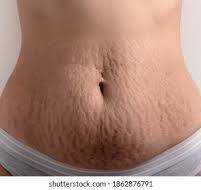As many as 90 percent of women will develop stretch marks during pregnancy, a startling statistic that highlights the prevalence of this common postpartum body change. These indented streaks on the skin, often pink, red, black, blue, or purple, are caused by rapid skin stretching and typically appear on the belly, buttocks, breasts, thighs, and lower back during the sixth and seventh months of pregnancy.
While stretch marks are a permanent part of many women’s postpartum journeys, there are various treatments and lifestyle changes that can help diminish their appearance and promote healthier, more resilient skin. In this comprehensive guide, we’ll explore 7 steps to get rid of stretch marks, from your post-pregnancy tummy to your arms and beyond.
Key Takeaways
- Up to 90% of women develop stretch marks during pregnancy
- Stretch marks commonly appear on the belly, buttocks, breasts, thighs, and lower back
- Stretch marks are a permanent but treatable part of the postpartum journey
- A combination of natural remedies, professional treatments, and lifestyle changes can help reduce the appearance of stretch marks
- Embracing your postpartum body and building a positive self-image are crucial for overall well-being
Understanding Stretch Marks After Pregnancy
Stretch marks, or striae gravidarum, are common scars that form when skin stretches rapidly during pregnancy, causing supportive structures in the middle or lower layers of skin to tear. These marks can appear on the abdomen, breasts, hips, and thighs, and their appearance can vary from person to person.
What Are Stretch Marks?
Stretch marks are the result of the skin’s inability to keep up with the rapid growth and expansion during pregnancy, weight gain, or growth spurts. They initially appear as flat, pinkish or reddish bands, and over time become longer, wider, and more textured.
Common Causes of Stretch Marks
Genetic factors play a significant role in the likelihood of developing stretch marks, with a family history increasing the chances. Younger mothers and those with higher pre-pregnancy weight or rapid weight gain during pregnancy are also more prone to developing stretch marks. Hormonal changes and conditions like Cushing’s syndrome or Marfan syndrome can also contribute to the formation of stretch marks.
When Do Stretch Marks Usually Appear?
Up to 90 percent of pregnant individuals will develop stretch marks by their third trimester. A 2013 study shows that some people have a genetic predisposition to getting stretch marks, and research indicates that individuals are more likely to get stretch marks during pregnancy if they are younger or gain weight quickly.
While stretch marks can be a source of self-consciousness for many, it’s important to remember that they are a natural and common part of the postpartum experience. Understanding the causes and timeline of stretch marks can help you develop a proactive approach to skin elasticity and postpartum wellness.
Natural Remedies for Stretch Marks
If you’re looking for natural ways to tackle post-pregnancy stretch marks, there are several effective options to explore. From essential oils to homemade scrubs, these natural remedies can help reduce the appearance of stretch marks and promote skin health.
Essential Oils for Stretch Mark Reduction
Massaging your skin with nourishing oils like Mustela’s Stretch Marks Oil can increase blood flow and break up scar tissue, leading to a visible improvement in stretch marks. Other essential oils like rosehip, centella asiatica, and sweet almond oil have also been shown to be beneficial.
Homemade Scrubs to Exfoliate Skin
Creating your own gentle scrubs using ingredients like sugar, almond oil, and lemon juice can help exfoliate and lighten stretch marks. Egg white peels provide nutrients like protein and potassium to maintain skin elasticity, while aloe vera gel and honey scrubs offer antiseptic properties and promote healing. These remedies work best on newer, pink or red stretch marks.

Remember, while natural remedies can be effective, patience and consistency are key when it comes to reducing the appearance of stretch marks. Incorporating these techniques into your post-pregnancy skincare routine can make a noticeable difference over time.
Nutrition Tips to Improve Skin Elasticity
Proper nutrition is crucial for maintaining healthy, elastic skin after pregnancy. By focusing on a diet rich in essential vitamins and minerals, you can support your body’s natural healing process and reduce the appearance of stretch marks over time.
Foods Rich in Vitamins A, C, and E
Incorporate foods high in vitamins A, C, and E into your post-pregnancy wellness routine. These vitamins play a vital role in skin cell regeneration, collagen production, and overall skin health. Some great options include:
- Carrots, sweet potatoes, and leafy greens for vitamin A
- Citrus fruits, bell peppers, and broccoli for vitamin C
- Nuts, seeds, and avocados for vitamin E
Staying Hydrated for Healthy Skin
Maintaining proper hydration is essential for skin elasticity and overall skin health. Experts recommend drinking at least eight cups of water daily to keep your skin cells functioning properly and aid in the recovery process from stretch marks. Staying hydrated can also help reduce the appearance of existing stretch marks over time.
| Nutrient | Benefits for Skin Health |
|---|---|
| Vitamin A | Promotes cell regeneration and collagen production, improving skin elasticity. |
| Vitamin C | Supports collagen synthesis, enhancing skin’s strength and firmness. |
| Vitamin E | Acts as an antioxidant, protecting skin from environmental stressors and promoting healing. |
By incorporating a balanced, healthy diet and staying hydrated, you can support your body’s natural post-pregnancy wellness and contribute to the gradual fading of stretch marks. Pair these nutrition tips with other self-care practices for a comprehensive skincare routine that helps you feel confident and comfortable in your postpartum body.
The Role of Regular Exercise
Maintaining a consistent exercise routine can play a significant role in preventing and reducing the appearance of stretch marks after pregnancy. Physical exercises not only strengthen the muscles in areas prone to stretch marks, such as the hips, thighs, and belly, but they also promote overall skin health and elasticity, which is crucial for postpartum body changes.
Effective Exercises for Stretch Mark Prevention
Incorporating a variety of low-impact exercises into your routine can be highly beneficial for your post-pregnancy wellness. Activities like walking, swimming, and prenatal yoga can help improve skin and muscle tone, while also boosting your confidence. Start with light exercises and gradually increase the frequency, focusing on consistency rather than intensity.
Yoga and Stretching Benefits
Yoga and stretching exercises offer additional benefits for skin elasticity and stress reduction. These practices can help improve circulation, promote relaxation, and contribute to overall skin health, which may aid in the reduction of stretch marks. Consistent practice of yoga and stretching can be a valuable part of your post-pregnancy wellness journey.
| Exercise | Benefits for Stretch Mark Reduction |
|---|---|
| Walking | Improves circulation, strengthens core muscles, and boosts skin elasticity. |
| Swimming | Low-impact exercise that works the entire body, promoting skin health and tone. |
| Prenatal Yoga | Enhances flexibility, reduces stress, and supports skin elasticity. |

Professional Treatments for Stretch Marks
While home remedies and lifestyle changes can help minimize the appearance of stretch marks, sometimes professional treatments are necessary to achieve more dramatic results. Certain medical procedures performed by dermatologists have been shown to be effective in reducing the visibility of stubborn stretch marks.
Laser Therapy Options
Laser therapies, such as pulse dye laser and intense pulsed light, can be quite effective in treating stretch marks. These treatments work by stimulating collagen production and reducing redness in newer stretch marks. Multiple sessions are typically required to see optimal results, but they can significantly improve the appearance of stretch marks over time.
Microneedling Benefits
Microneedling is another popular professional treatment for stretch marks. This procedure involves creating tiny punctures in the skin to trigger the body’s natural healing response and boost collagen and elastin production. Microneedling is often more effective on newer stretch marks and can be combined with other treatments for enhanced results.
In addition to laser therapy and microneedling, radiofrequency treatments that use energy waves to tighten the skin and increase collagen can also be beneficial for improving the appearance of stretch marks. As with any medical procedure, it’s important to consult a board-certified dermatologist to determine the most suitable option based on your individual needs and skin type.
While professional treatments cannot completely eliminate stretch marks, they can make a significant difference in their visibility. By stimulating new collagen and skin tissue growth, these procedures can help fade the appearance of stretch marks and smooth out the skin’s texture. With the guidance of a skincare expert, you can develop an effective treatment plan to address your postpartum body changes and regain your confidence.
Topical Treatments to Consider
When it comes to fading those pesky stretch marks, topical treatments can be a game-changer. Prescription creams containing tretinoin, a type of retinoid, have been shown to improve the appearance of stretch marks, especially when used early on. For over-the-counter options, look for products infused with hyaluronic acid – these can help make those early-stage stretch marks less noticeable.
Seeking out creams and lotions with natural ingredients like cocoa butter, vitamin E, or almond oil can also be beneficial. While the evidence on their effectiveness may vary, these nourishing formulas can help keep your skin moisturized and reduce the itchiness often associated with stretch marks.
Creams and Lotions for Stretch Marks
- Advanced Clinicals Retinol Advanced Firming Cream – 28% off and over 30,000 five-star reviews on Amazon
- Maelys Cosmetics B-Flat Belly Firming Cream – $49 price tag
- Differin Adapalene Gel Acne Treatment – 16% off
- Palmer’s Cocoa Butter Formula Massage Cream – 31% off and boosts skin hydration by 56% for over six hours
- Buttah Skin CocoShea Revitalizing Cream – $21 price
- Body Merry Stretch Marks and Scars Defense Cream – Over 4,000 positive reviews on Amazon
- Mutha Body Butter – $95 price tag
Natural Ingredients to Look For
When browsing the skincare routine aisle for stretch mark removal, keep an eye out for products containing natural ingredients like cocoa butter, vitamin E, or almond oil. These nourishing components can help keep your skin hydrated and minimize the appearance of those unwanted marks.

Remember, while the effectiveness of natural remedies may vary, staying consistent with your skincare routine and keeping your skin well-moisturized can go a long way in supporting your journey to smoother, more radiant skin.
Lifestyle Changes for Skin Health
During the postpartum period, prioritizing your self-care routine can make a significant difference in your skin’s health and the appearance of stretch marks. By implementing simple lifestyle adjustments, you can support your body’s natural healing process and promote overall skin elasticity.
Importance of Sleep and Stress Management
Adequate sleep is crucial for skin regeneration and healing. Aim for 7-9 hours of quality sleep each night to allow your body to rest and rejuvenate. Additionally, incorporating stress management techniques, such as meditation or gentle yoga, can help reduce cortisol levels and improve your overall well-being, which in turn can benefit your skin’s condition.
Avoiding Harsh Chemicals in Skincare
During pregnancy and while breastfeeding, it’s important to be mindful of the products you use on your skin. Opt for gentle, hypoallergenic skincare items that are free from harsh chemicals, such as retinoids or parabens. These ingredients can be potentially harmful, especially in the early postpartum period. Instead, choose nourishing, natural ingredients that can help soothe and hydrate your skin.
Consistent skincare routines, including regular moisturizing, can also help maintain skin elasticity and improve the appearance of stretch marks over time. By prioritizing self-care and making conscious choices about your lifestyle and skincare, you can support your body’s natural healing process and enhance your post-pregnancy wellness.
Embracing Your Body Post-Pregnancy
Postpartum body changes can be a profound transformation, and embracing this journey is crucial for your mental well-being. Stretch marks, a common and natural result of pregnancy, affect up to 90% of women. These marks represent the incredible ability of your body to bring new life into the world. Rather than focusing on perceived flaws, shift your mindset to celebrate the amazing capabilities of your body.
Celebrating Your Transformation
Your postpartum body is a testament to the strength and resilience you’ve displayed throughout your pregnancy and childbirth. Embrace the changes, knowing that they are a natural part of the process. Remember, every woman’s postpartum journey is unique, and there is no one-size-fits-all approach to healing and self-acceptance.
Building a Positive Body Image
Cultivating a positive body image after pregnancy involves a multifaceted approach. Engage in self-care practices, such as pampering your skin with postpartum body changes treatments and nourishing your body with post-pregnancy wellness habits. Surround yourself with supportive people who celebrate your journey and encourage your self-care tips. Most importantly, practice self-compassion and remember that the healing process takes time.

Embrace the unique and beautiful changes in your body, and remember that you are not alone in this journey. By celebrating your transformation and building a positive body image, you can navigate the postpartum body changes with grace and self-love, empowering you to thrive in your post-pregnancy wellness.
Conclusion: Steps to Effective Stretch Mark Reduction
Effective stretch mark reduction requires a multifaceted approach. Consistently moisturizing the skin, incorporating targeted exercises, maintaining a nutrient-rich diet, and staying hydrated are key methods to address the appearance of stretch marks. Complementing these lifestyle changes with natural remedies and topical treatments can further enhance results.
Summary of Key Methods
Topical creams and lotions containing ingredients like retinoids, hyaluronic acid, and Centella asiatica may stimulate collagen production and improve skin elasticity. Professional treatments such as laser therapy, microneedling, and platelet-rich plasma (PRP) therapy can also significantly reduce the visibility of existing stretch marks. Exfoliating with natural scrubs and incorporating aloe vera or virgin coconut oil into your skincare routine can help diminish their appearance.
Encouragement to Begin Your Journey
Remember, addressing stretch marks is a journey, and early intervention is often more effective. Be patient with your body’s healing process and celebrate the small improvements you see along the way. Every step you take towards reducing stretch marks is a step towards regaining confidence in your postpartum body. Start your journey with realistic expectations and a positive mindset, and you’ll be well on your way to achieving your desired skin transformation.

